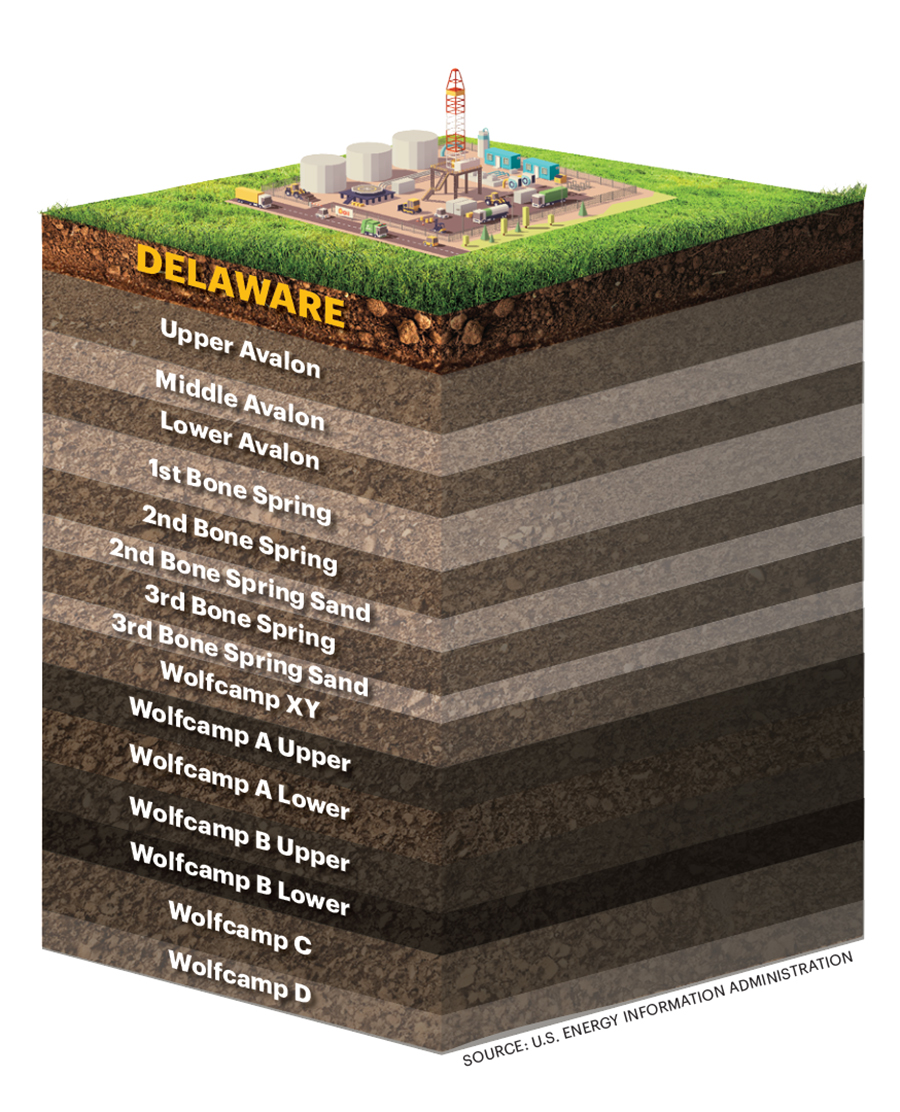
Occidental is exploring upside in the Permian’s secondary benches, executives said in fourth-quarter earnings on Feb. 19. (Source: Shutterstock)
Occidental Petroleum plans to boost development of secondary Permian Basin benches this year, particularly in the Delaware Basin.
The company plans to allocate 30% of its Delaware Basin drilling program to secondary benches this year, up from around 25% in 2024, said Richard Jackson, Oxy’s president of operations, U.S. onshore resources and carbon management, during fourth-quarter earnings on Feb. 19.
Oxy’s secondary zones in the Delaware Basin include the upper Bone Spring intervals and the deeper Wolfcamp C and D zones, Jackson said on an earnings call last spring.

Flowing production from secondary benches through existing facilities helps improve economics for the emerging zones, he said.
For example: Every new well drilled in Oxy’s New Mexico development program during third-quarter 2024 used existing infrastructure.
“From a total cost per barrel for the year, you’re coming out much more advantaged,” Jackson said. “You can double or even triple your return when you're looking at a development program with that sort of benefit coming from facilities.”
Oxy added significant runway in the Midland Basin through a $12 billion acquisition of CrownRock, which closed last August.
The CrownRock assets are expected to average over 170,000 boe/d this year, up 5% year-over-year, said CFO Sunil Mathew.
Oxy’s primary benches in the Midland Basin include the Spraberry, Wolfcamp A and B and some Dean wells, Jackson told investors last year.
Permian Barnett Shale
Oxy has also been a leader in testing the secondary Barnett Shale bench in the Midland Basin.
Occidental Permian Ltd. produced approximately 3.85 MMBoe (54% oil) from the Midland Basin’s Emma Barnett Field during 2024, an average of 10,530 boe/d, according to Texas Railroad Commission (RRC) data.
That includes nearly 2.1 MMbbl of crude oil and over 10.5 Bcf of natural gas.
Oxy has drilled several Barnett wells on the South Curtis and Johnson ranches in Midland and Martin counties, Texas, where depths have reached about 11,200 ft.
Barnett wells will continue to play a part in Oxy’s Permian development program this year, said Thaimar Ramirez, president and general manager of Oxy’s Midland Basin Business Unit, during Hart Energy’s Executive Oil Conference & Expo.
Oxy’s entire Permian production is expected to average between 745,000 boe/d and 765,000 boe/d during the first quarter.
RELATED
Shale Outlook Permian: The Once and Future King Keeps Delivering
Rockies, Permian divestitures
Oxy is selling $1.2 billion in non-core upstream assets under agreements signed in the first quarter.
The divestitures to undisclosed buyers include non-operated assets in the Rockies and Permian Basin assets not included in Oxy’s near-term development plan.
Proceeds from the divestitures will be applied to the company’s remaining 2025 debt maturities.
Executives and company representatives offered few details about the divestiture agreements.
But rumors have swirled that Oxy was marketing a minerals and royalties package in Colorado’s Denver-Julesburg (D-J) Basin for between $900 million and $1 billion.
As of year-end, Oxy held 600,000 net acres in the D-J Basin—down from 700,000 net acres as of the end of the third quarter.
Production from the divested non-operated Rockies assets averaged around 13,000 boe/d, according to investor materials. The latest Rockies sale is expected to close during the first quarter.
During the third quarter, Oxy also sold non-core properties in Wyoming’s Powder River Basin to private operator Anschutz Exploration for an undisclosed sum, CEO Vicki Hollub confirmed on an earnings call.
The company holds approximately 100,000 net acres in the Powder River, down from the 300,000 net acres listed in investor materials last year.
RELATED
NAPE Panelist: Occidental Shops ~$1B in D-J Basin Minerals Sale
Recommended Reading
Energy Transfer, MidOcean Agree to Jointly Develop Lake Charles LNG
2025-04-09 - Under a non-binding heads of agreement with Energy Transfer, MidOcean Energy would fund 30% of Lake Charles LNG's project costs and be entitled to 30% of production—contingent on a final investment decision, the companies said.
Australia's Woodside in Talks with at Least Three Partners for Louisiana LNG, Sources Say
2025-02-18 - Woodside Energy has held talks with several potential buyers of stakes in its Louisiana LNG plant, including Tokyo Gas, Japan's JERA and Saudi Aramco-backed MidOcean Energy, multiple sources told Reuters.
Petrobras Signs on for 15 Years of LNG from Centrica
2025-02-20 - Petróleo Brasileiro SA has signed a 15-year purchase and sale agreement with British global natural gas supplier Centrica.
Kinder Morgan Sees Strong Gas Market, Despite Political Noise
2025-04-17 - Kinder Morgan is undeterred by “perceived ups and downs” in the natural gas market, said Executive Chairman Rich Kinder during the company’s first earnings call of 2025.
Woodside to Supply Europe’s Uniper with Up to 2 mtpa of LNG
2025-04-17 - Woodside Energy has signed a sale and purchase agreement to supply Uniper with up to 2 million tonnes per annum of LNG, subject to a final investment decision on its Louisiana LNG project.
Comments
Add new comment
This conversation is moderated according to Hart Energy community rules. Please read the rules before joining the discussion. If you’re experiencing any technical problems, please contact our customer care team.





